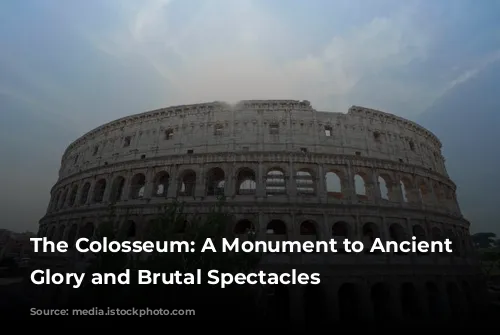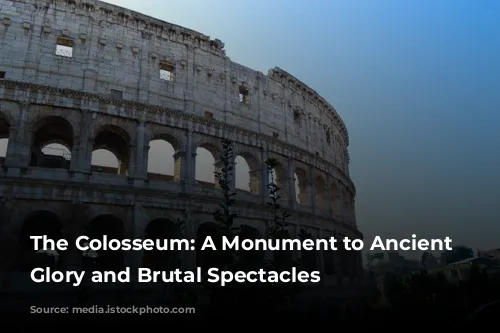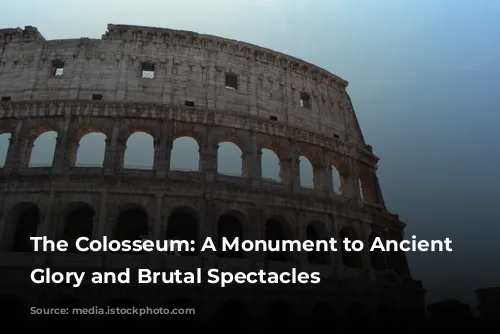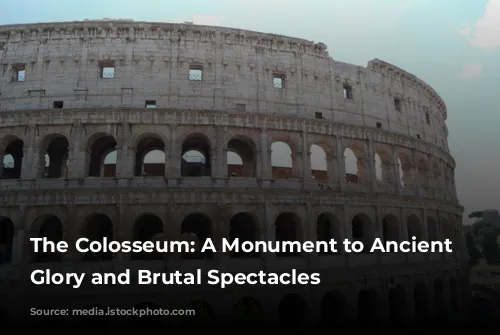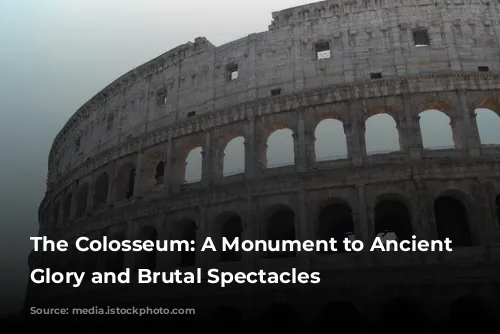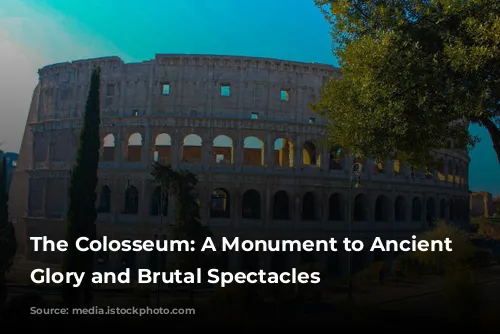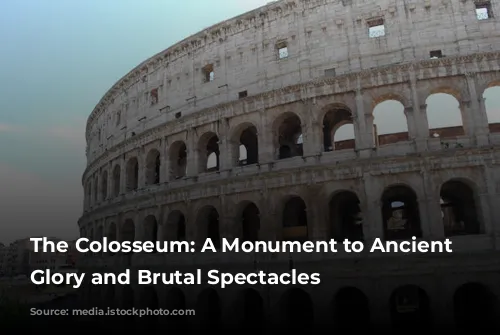The Colosseum, also known as the Flavian Amphitheatre, stands as a testament to the grandeur of ancient Rome. This iconic structure, the largest and most imposing amphitheatre in the Roman world, is a symbol of Roman power and ingenuity. It was initiated by Emperor Vespasian of the Flavia family and inaugurated by his son Titus in 80 AD.
A Grand Opening and the Origin of its Name
The Colosseum’s grand opening was an extravagant affair, lasting an incredible one hundred days. The crowds were treated to a dazzling spectacle of gladiatorial combat, animal hunts, and even naumachias—real sea battles recreating famous historical naval encounters. The arena was flooded with water for these breathtaking events, showcasing the Romans’ mastery of engineering.
But why is it called the Colosseum? The name first appeared in a prophecy by the Venerable Bede, a medieval monk, who wrote: “Rome will exist as long as the Colosseum does; when the Colosseum falls so will Rome; when Rome falls so will the world”. It’s believed that Bede may have derived the name from the colossal statue of Emperor Nero, known as “the Colossus”, which stood near the amphitheatre. This massive statue, unfortunately, has been completely destroyed.
Architectural Brilliance and a Lost Masterpiece
The Colosseum is an architectural marvel. Originally covered in dazzling white travertine stone slabs, the amphitheatre is elliptical in shape, allowing for maximum seating capacity. It boasted four floors, with the first three featuring eighty arches each, adorned with magnificent statues.
It’s almost unbelievable that this massive structure was built in less than a decade. How did the Romans achieve this feat? The answer lies in their mastery of the arch. This architectural technique, used extensively in Roman aqueducts, allowed the Romans to distribute the weight of heavy constructions efficiently and effectively.
The Colosseum, in essence, was like a series of aqueducts built one atop another. Today, we see only a skeleton of the once-glorious arena. Three-fifths of the outer brick wall are missing, a testament to the Colosseum’s sad fate.
A Quarry of Marble, Lead, and Iron
In the Middle Ages, the Colosseum, no longer in use for its original purpose, became an enormous quarry. The Popes plundered its marble, lead, and iron to build structures like the Barberini Palace, Piazza Venezia, and even St. Peter’s Basilica. The holes still visible in many columns are a reminder of this period of exploitation, marking the points from which lead and iron were extracted.
Seating, Social Status, and Protection from the Sun
The Colosseum could accommodate up to 70,000 spectators, offering a breathtaking view from every seat. Entry was free for all Roman citizens, but seating was strictly divided based on social status, much like modern theatres. The top tiers were reserved for the common people, with separate sections for men and women. As one descended towards the arena, social status increased, culminating in the front row, where senators, vestals, priests, and, of course, the Emperor held court.
The Romans were pioneers of stadium design, ensuring spectator comfort. An ingenious roof covering, the “Velarium”, protected the crowd from the harsh sun. This massive linen tarpaulin was suspended by a system of ropes, winches, and wooden poles attached to the top of the outer wall. One hundred sailors from the Imperial fleet were needed to manipulate this complex system, moving the velarium in perfect synchrony to the beat of a drum.
The Arena and its Spectacular Displays
As you enter the Colosseum, the arena lies directly before you. The floor, once a mixture of brick and wood, has vanished, revealing the cellars that housed equipment used for preparing and executing the games.
Two underground floors contained lifts and hoists with counterweights, the rails of which are still visible today. These were the special effects of their time, used to hoist up animals and gladiators who would suddenly appear in the arena through trapdoors, creating thrilling surprises for the audience.
A sophisticated system of hinges and lifts also allowed the Romans to raise elaborate backdrops, setting the stage for the spectacular hunts. The shows in the Colosseum, a mix of symbolism and spectacle, were a way for the Emperor to connect with the people, offering shared experiences and entertainment, all while subtly diverting their attention from political problems.
The Games: From Animal Hunts to Gladiatorial Combat
The Colosseum was a stage for a variety of shows, each taking place at a specific time. The morning was reserved for “Venationes”—fights between exotic animals, or between humans and animals. Sometimes, as a form of public execution, individuals were left to the mercy of ferocious beasts. The “Silvae” must have been especially spectacular, with elaborate sets recreating forests filled with animals, some of which were spared.
There were also less brutal and more unique events, like the famous display of an elephant who could write words in the sand with its trunk. Despite popular belief, the Colosseum was not used for the systematic killing of Christians as a form of entertainment.
The Thrilling spectacle of Gladiatorial Combat
The Colosseum’s most popular event, though, was the gladiatorial combat. After a midday break, during which the arena was cleared of debris and fresh sand was spread on the floor, the gladiators would parade into the packed arena to a deafening roar from the crowd. Accompanied by the blaring of trumpets and the beating of drums, they emerged from an underground passageway connected to their barracks, the Ludus Magnus. They were greeted like heroes, much like modern sports champions.
The gladiators would then perform a symbolic walk around the arena, paying homage to the Emperor by saluting with the famous words: “Ave Cesare morituri te salutant” (Hail Caesar, those who are about to die salute you).
The Gladiators: Warriors, Slaves, and Entertainers
The term “gladiator” comes from the Gladius, the short sword used by legionaries. Contrary to popular belief, gladiators were not always forced to fight against their will. Many were prisoners of war who were given the choice of becoming slaves or fighting in the arena for a limited period, after which they would be freed. Some gladiators, however, were simply impoverished individuals seeking fame and fortune.
Their profession offered good pay and immense popularity, particularly with women who were known to pay significant sums for a night with a handsome gladiator. There were twelve types of gladiators, each with their unique weapons and fighting styles.
For example, the “Retiarius” fought with a net, a trident, and a knife, while others wielded a shield and a sickle. Gladiators from different categories were matched for dramatic effect.
Life and Death in the Arena
If a gladiator was wounded, he could plead for mercy by raising an arm. The audience would then shout their plea to the Emperor, who would decide the gladiator’s fate. A thumbs-up signified mercy, while a thumbs-down meant death.
Victorious gladiators were rewarded with golden palm leaves and significant sums of money. After each battle, servants dressed as Charon, the Ferryman of the Underworld, would ensure that the wounded were truly dead, often finishing them off. Gladiator’s blood was believed to have healing properties, used to treat epilepsy and enhance sexual vigor.
The Colosseum’s Legacy and Evolution
Roman spectators reveled in the brutal spectacles of the Colosseum, finding pleasure in what we consider violent entertainment. This passion for gladiatorial combat is comparable to modern-day interest in “splatter” cinema, with one crucial difference: the raw reality of the Colosseum’s shows. The stench of blood, burnt flesh, and wild animals was unbearable, despite attempts to mask it with incense and perfumes.
After the 6th century, with the decline of the Roman Empire, the Colosseum fell into disuse. Its walls became home to confraternities, hospitals, hermits, and even a cemetery. From the Middle Ages onwards, the Colosseum became one of Rome’s and the world’s most remarkable landmarks, attracting throngs of visitors.
Threatened with demolition by Pope Sixtus V, the Colosseum was declared a sacred monument dedicated to the Passion of Christ by Pope Benedict XIV. A cross was placed on a pedestal, symbolizing the suffering of Christian martyrs. This cross is still the starting point for the Stations of the Cross on Good Friday.
Since then, the Colosseum has become a symbol of Christian faith, protected from further destruction and ruin. It stands as a testament to the grandeur of ancient Rome, a monument to both the power and the brutality of a bygone era. For tourists today, a visit to the Colosseum, as Charles Dickens aptly described it, is “seeing the ghost of old Rome floating over the places its people walk in”.
